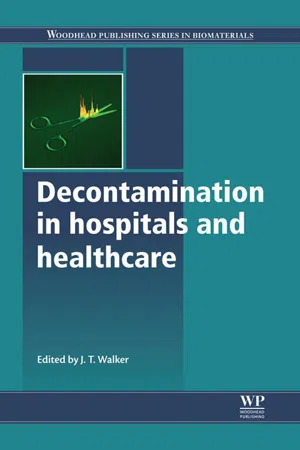
- 704 pages
- English
- ePUB (mobile friendly)
- Available on iOS & Android
Decontamination in Hospitals and Healthcare
About this book
Decontamination in Hospitals and Healthcare brings an understanding of decontamination practices and the development of technologies for cleaning and control of infection to a wide audience interested in public health, including healthcare specialists, scientists, students or patients.Part one highlights the importance and history of decontamination in hospitals and healthcare before exploring the role of standards in decontamination, infection control in Europe, and future trends in the area. Part two focuses on decontamination practices in hospitals and healthcare. It considers the role of the nurse in decontamination, the issues of microbial biofilm in waterlines, control of waterborne microorganisms, and the use of gaseous decontamination technologies. Further chapters explore decontamination of prions, the use of protective clothing, no-touch automated room disinfection systems, and controlling the presence of microorganisms in hospitals. Part three discusses practices for decontamination and sterilization of surgical instruments and endoscopes. These chapters examine a range of guidance documents, including the choice framework for local policy and procedures for decontamination of surgical instruments, as well as novel technologies for cleaning and detection of contamination.Decontamination in Hospitals and Healthcare provides a reference source on decontamination for public health professionals and students concerned with healthcare. It is particularly useful for scientists in microbiology and disinfection/decontamination laboratories, healthcare workers who use disinfectants, students in microbiology, clinicians, members of the Institute of Decontamination Sciences/Central Sterilising Club, and those employed in the Central Sterile Services departments of healthcare facilities.- Discusses decontamination processes in Europe- Provides an in-depth understanding into decontamination in healthcare settings, specifically hospitals and dental practices- Examines the decontamination of surgical equipment and endoscopes
Frequently asked questions
- Essential is ideal for learners and professionals who enjoy exploring a wide range of subjects. Access the Essential Library with 800,000+ trusted titles and best-sellers across business, personal growth, and the humanities. Includes unlimited reading time and Standard Read Aloud voice.
- Complete: Perfect for advanced learners and researchers needing full, unrestricted access. Unlock 1.4M+ books across hundreds of subjects, including academic and specialized titles. The Complete Plan also includes advanced features like Premium Read Aloud and Research Assistant.
Please note we cannot support devices running on iOS 13 and Android 7 or earlier. Learn more about using the app.
Information
The importance of decontamination in hospitals and healthcare*
Abstract
1.1 Introduction
1.2 Microbial resistance and infection control
| Resistance | Microorganisms |
| Very resistant | Prions |
| More resistant | Bacterial spores |
| Less sensitive | Mycobacteria, protozoal cysts and non-enveloped viruses (Polis, Hep A) |
| Most sensitive | Vegetative bacteria, enveloped viruses (HIV, RSV, Hep B), fungi (and their spores), non-encysted protozoa |
Table of contents
- Cover image
- Title page
- Table of Contents
- Copyright page
- Contributor contact details
- Woodhead Publishing Series in Biomaterials
- Acknowledgements and dedication
- Part I: Fundamentals of decontamination in hospitals and healthcare
- Part II: Decontamination practices in hospitals and healthcare
- Part III: Decontamination of surgical instruments and endoscopes
- Index